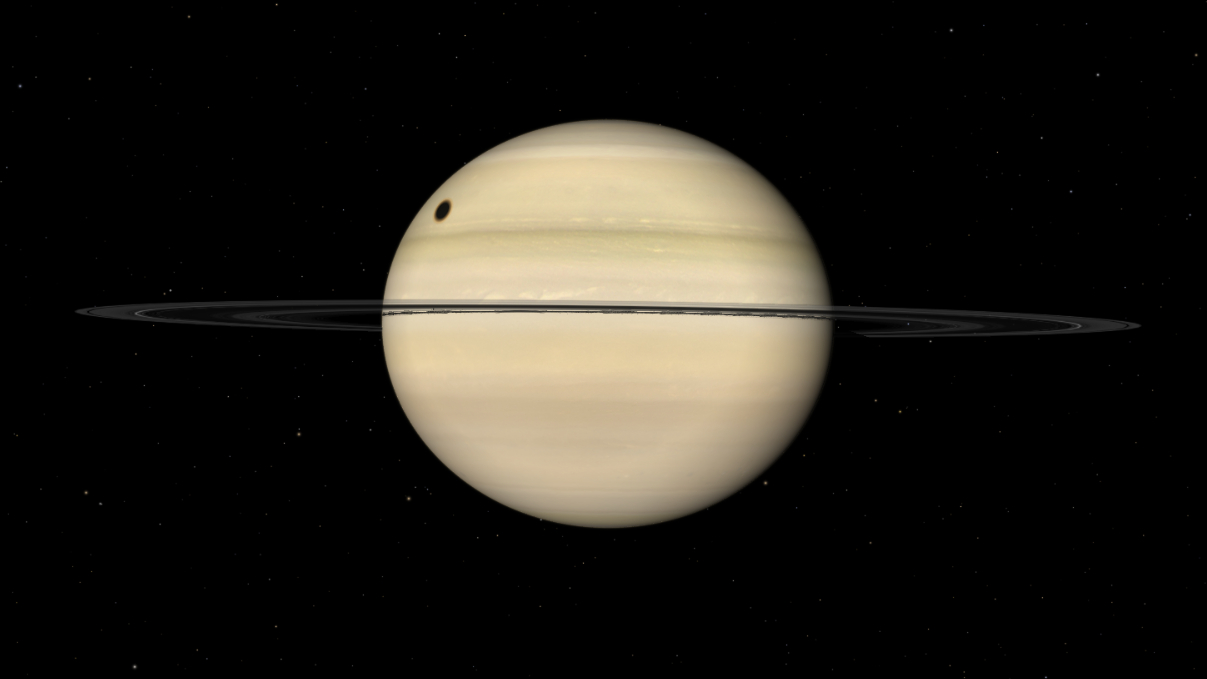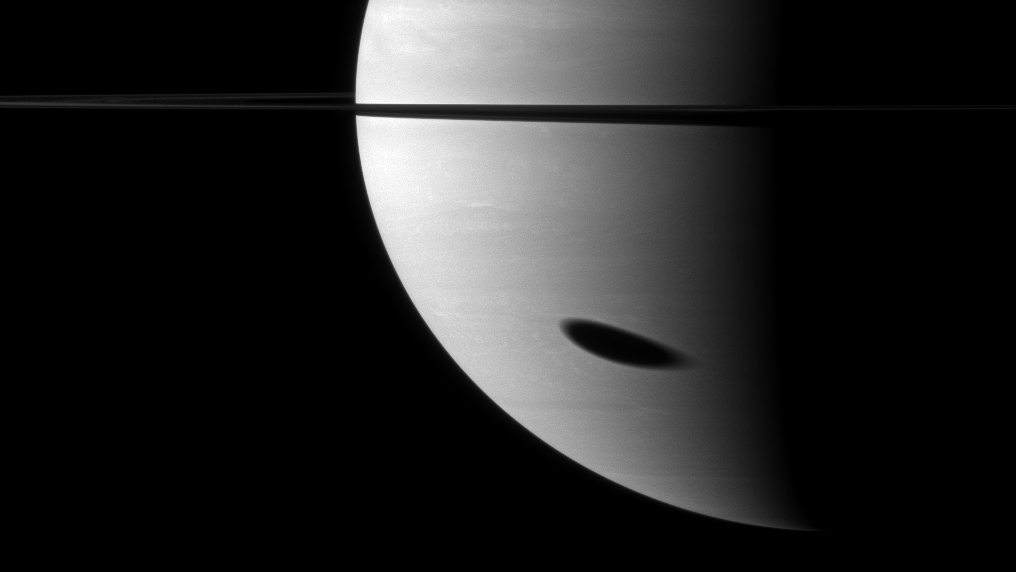Early risers will get a rare opportunity to see something extraordinary in the early hours of July 18 — the dark shadow of Saturn's largest moon, Titan, sweeping across the planet's cloud tops.
Once every 15 years, Saturn's tilted orbit brings its iconic rings — and Titan's orbital path — into an edge-on alignment with Earth. This event, known as a ring-plane crossing, heralds the onset of a season of dramatic 'shadow transits', as Titan's vast umbral silhouette periodically sweeps across the gas giant's surface.
"Sighting a shadow transit of Titan for an amateur astronomer is somewhat the equivalent of a fisherman hooking and reeling in a particularly large or elusive fish," Hayden Planetarium instructor and lecturer Joe Rao told Space.com in an email. "It is so unusual a sight that doesn't happen very often, which is why even veteran skywatchers are excited at the possibility of making such a sighting."
When is Titan's shadow transit?
Titan's next shadow transit will get underway at 3 a.m. EDT (0700 GMT) on July 18, at which time the moon's dark outline will be visible slowly progressing across Saturn's cloudy disk, according to Sky and Telescope.
Look for Saturn in the southeastern sky, just below the stars of the constellation Pisces shining like a bright star to the naked eye, with the moon in the east.
Observers in the U.S. will have a good view of the first two hours of the shadow transit, but by the time Titan's shadow leaves Saturn's disk at 8:05 a.m. EDT (12:05 GMT), the brightening dawn will overpower the view.
How powerful does a telescope need to be to spot Titan's shadow?
At the time of the shadow transit, Titan and Saturn will be separated by approximately 846 million miles (1.36 billion kilometers) from Earth — far beyond the capabilities of the naked eye or binoculars, but well within reach of many amateur telescopes.
We asked Rao for guidance on the kind of scope needed to view Titan's shadow transit. "An 8-inch telescope at 200-power or a 10-inch telescope at 250-power should provide a good view of Titan's shadow, especially on a night of good seeing," Rao explained.

To calculate the magnifcation of your telescope, you need only divide its focal length by the focal length of your chosen eyepiece. For example, a 1000 mm telescope with a 10 mm eyepiece yields 100-power magnification.
Rao also emphasised that stable atmospheric conditions are crucial to obtaining a clear view. This becomes more important when using higher power with a smaller aperture scope. It's best to use one-half magnification/power when viewing distant objects to avoid them appearing to "boil", or "scintilate" when viewed through the eyepiece.
"At least 200-power is necessary for getting a reasonably good view of the dark 'shadow dot' projected on Saturn's disk," continued Rao. "The general rule of thumb is to utilize 50-power for every inch of aperture of the telescope objective, or mirror. So, for a 4-inch telescope, the maximum magnification to be used is 200-power, which is considered the limit for a telescope of that size."
When are the next Titan shadow transits?
After the July 18 event, five more Titan shadow transits will be visible from Earth. Each occurs roughly16 days after the last — a result of Titan's 16-day orbital period — and starting progressively earlier in the night for viewers in the U.S.
Swipe to scroll horizontally
Date | Start | End |
Aug 3 | 2:25 a.m. | 7:04 a.m. |
Aug 19 | 1:52 a.m. | 6:00 a.m. |
Sept 4 | 1:25 a.m. | 4:50 a.m. |
Sept 20 | 1:09 a.m. | 3:34 a.m. |
Oct 6 | 1:32 a.m. | Row 5 - Cell 2 |
The next transit after this week will begin at 2:25 a.m. (0625 GMT) on August 3, while the last chance to catch the moon's shadow fall on Saturn will take place on October 6.
After the October event, stargazers will have to wait another 15 years before the next ring crossing brings Titan — and its shadow — into alignment once more!
Titan's shadow through the eyes of the Cassini spacecraft
Without question, the most spectacular views of a Titan shadow transit came courtesy of NASA's Cassini spacecraft, which witnessed the moon's dark outline fall over Saturn's cloud surface in November 2009, while it travelled a mere 1.3 million miles (2.1 million km) from the colossal gas giant. Cassini has long since found its resting place beneath the cloud surface of Saturn, but amateur astronomers will have an opportunity to follow in Cassini's steps later this week and witness the next Titan shadow transit for themselves when it takes place on July 18.
"Though we, living in the 21st century, have grown accustomed to seeing the Saturnian system through the eyes of Cassini, there still remains the thrill of witnessing, with one's own eyes, a major celestial event in the life of another planet a billion miles away," Carolyn Porco, planetary scientists and imaging team leader for NASA's Cassini mission told Space.com in an email.

Editor's Note: If you would like to share your images of the Titan shadow transit with Space.com's readers, then please send your photo(s), comments, and your name and location to [email protected].

.jpg) 5 hours ago
1
5 hours ago
1
 English (US)
English (US)